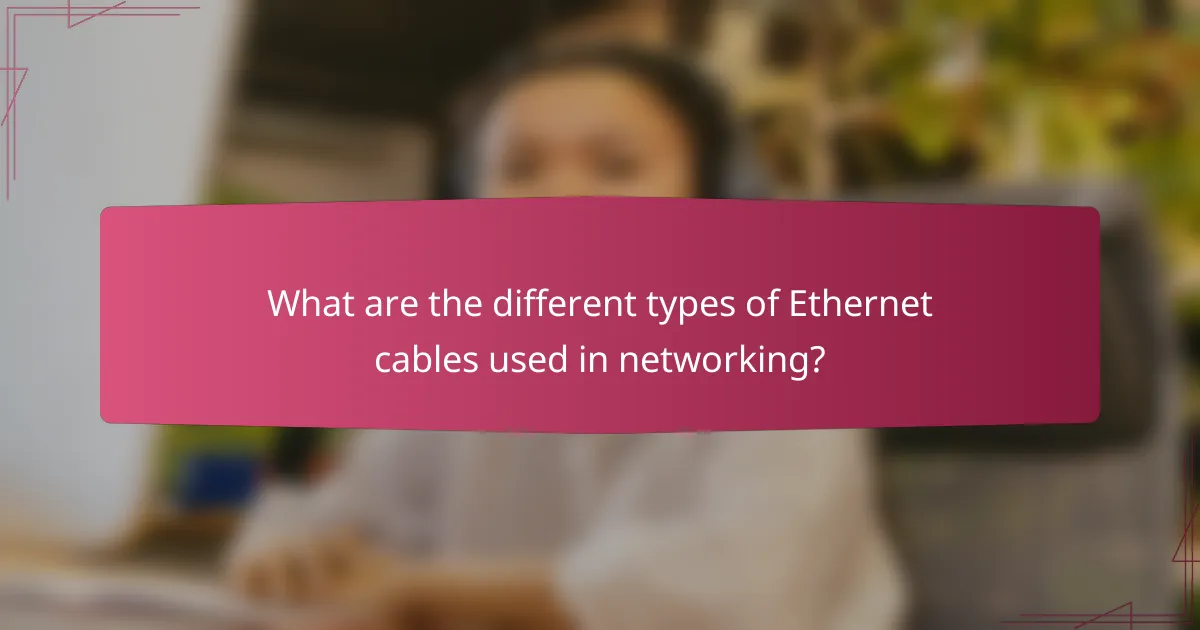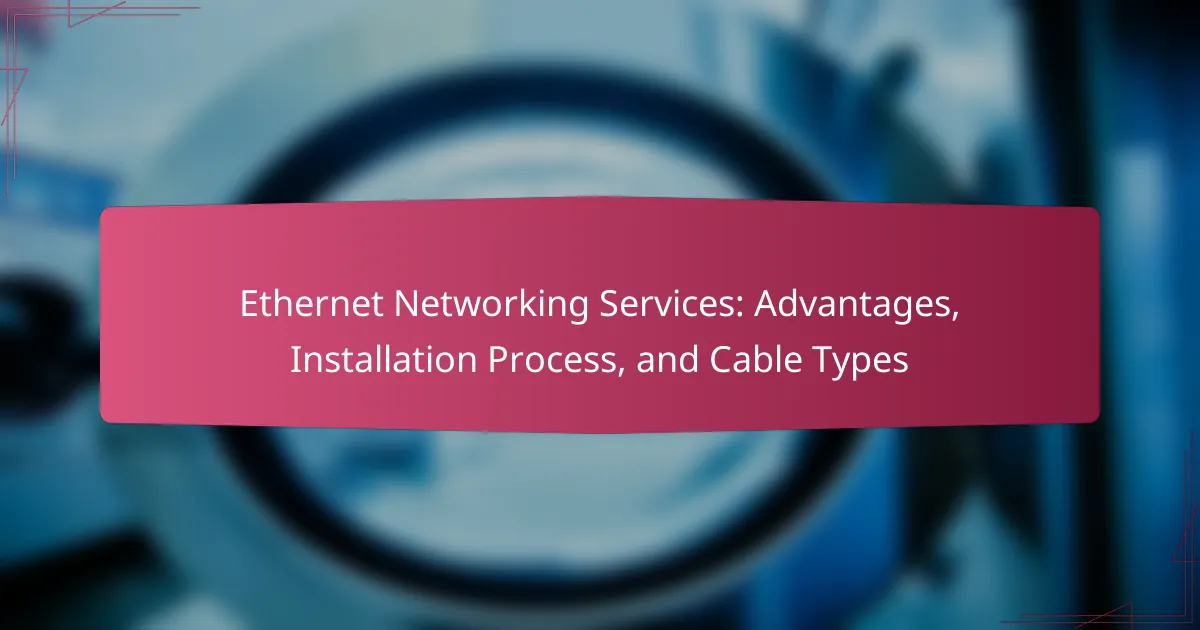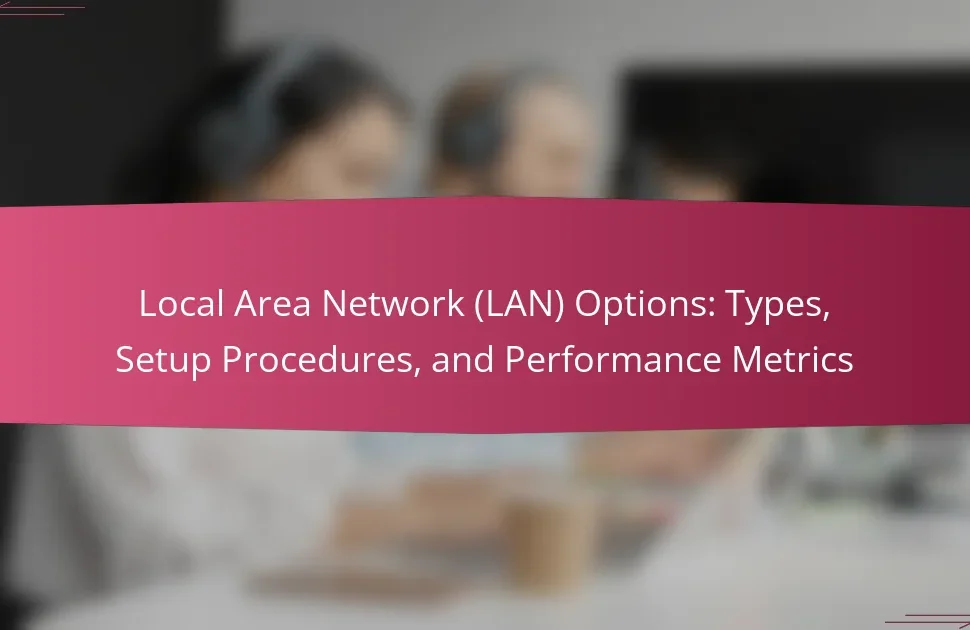
What are Ethernet Networking Services?
Ethernet networking services refer to a range of services that utilize Ethernet technology for data transmission. These services include local area network (LAN) connectivity, wide area network (WAN) services, and internet access. Ethernet networking supports high-speed data transfer, typically ranging from 10 Mbps to 100 Gbps. It is widely used in both residential and commercial settings due to its reliability and scalability. Ethernet technology also allows for the integration of various devices, such as computers, printers, and servers, within a network. According to the IEEE 802.3 standards, Ethernet is a well-defined protocol for network communication. This standardization ensures compatibility and interoperability among different devices and manufacturers.
How do Ethernet Networking Services function?
Ethernet Networking Services function by facilitating data transmission over a network using Ethernet technology. These services utilize a series of protocols that govern how data packets are sent and received. Ethernet operates primarily at the data link layer of the OSI model. It uses MAC addresses to identify devices on the network. Data is encapsulated into frames for transmission. Each frame contains source and destination addresses. Ethernet services support various speeds, commonly 10 Mbps, 100 Mbps, 1 Gbps, and 10 Gbps. They can connect devices within local area networks (LANs) and can extend to wide area networks (WANs) through routers. Ethernet is widely used due to its reliability and speed.
What are the key components of Ethernet Networking Services?
The key components of Ethernet Networking Services include network cables, switches, routers, and network interface cards (NICs). Network cables, such as Cat5e or Cat6, facilitate data transmission between devices. Switches connect multiple devices within the same network, allowing for efficient data routing. Routers manage traffic between different networks and provide internet connectivity. Network interface cards enable devices to connect to the network. Together, these components create a robust Ethernet networking environment.
How do these components interact in a network?
Components in an Ethernet network interact through a structured communication protocol. Ethernet uses frames to transmit data between devices. Each device, such as switches and routers, processes these frames based on MAC addresses. When a device sends data, it encapsulates it in a frame and broadcasts it to the network. The receiving device checks the frame’s destination address. If it matches its own MAC address, the device processes the data. If not, the frame is ignored. This interaction allows for efficient data transfer and minimizes collisions. Ethernet operates at the data link layer, ensuring reliable communication between connected devices.
What advantages do Ethernet Networking Services provide?
Ethernet Networking Services provide high-speed data transfer and reliable connectivity. They support bandwidths up to 10 Gbps or more, facilitating efficient communication. Ethernet networks are scalable, allowing easy expansion as business needs grow. They offer low latency, which is crucial for real-time applications like video conferencing. Ethernet is cost-effective, with lower installation and maintenance costs compared to other networking technologies. Security features such as VLANs enhance data protection within the network. The technology is widely supported, ensuring compatibility with various devices and systems. Overall, these advantages make Ethernet a preferred choice for both businesses and home networks.
How do Ethernet Networking Services enhance network performance?
Ethernet Networking Services enhance network performance by providing high-speed data transfer capabilities. They support data rates of up to 10 Gbps, significantly improving bandwidth. This increased speed reduces latency and enhances the overall responsiveness of applications. Ethernet services also offer reliable connectivity, minimizing packet loss during transmission. They utilize advanced error-checking mechanisms, ensuring data integrity. Ethernet’s scalability allows networks to grow without performance degradation. Additionally, these services facilitate efficient network management, optimizing resource allocation. Overall, Ethernet Networking Services create a robust and efficient network environment.
What cost benefits are associated with Ethernet Networking Services?
Ethernet Networking Services offer significant cost benefits. They typically reduce operational costs due to lower maintenance requirements. Ethernet networks are scalable, allowing businesses to expand without incurring high costs. The technology supports high data transfer rates, enhancing productivity and efficiency.
Moreover, Ethernet solutions often have lower hardware costs compared to other networking technologies. For instance, the average cost of Ethernet switches has decreased by over 50% in the past decade. This reduction makes Ethernet a cost-effective choice for businesses.
Additionally, Ethernet’s compatibility with existing infrastructure minimizes upgrade expenses. It also reduces energy consumption, leading to lower utility bills. Overall, these factors contribute to substantial long-term savings for organizations utilizing Ethernet Networking Services.
What industries commonly use Ethernet Networking Services?
Ethernet Networking Services are commonly used in several industries. These include telecommunications, healthcare, education, and finance. In telecommunications, Ethernet connects various network infrastructures. Healthcare facilities utilize Ethernet for reliable data transfer and medical device connectivity. Educational institutions rely on Ethernet for internet access and networked learning environments. The finance sector employs Ethernet for secure and fast transaction processing. Each of these industries benefits from Ethernet’s high speed and reliability.
How do different sectors implement Ethernet Networking Services?
Different sectors implement Ethernet Networking Services by tailoring solutions to their specific needs. In healthcare, Ethernet is used for secure patient data transfer and telemedicine applications. Educational institutions utilize Ethernet for high-speed internet access and online learning platforms. Retail businesses adopt Ethernet to manage point-of-sale systems and inventory tracking efficiently. Manufacturing sectors implement Ethernet for connecting machinery and enabling automation processes. Financial services rely on Ethernet for secure transactions and real-time data analysis. Each sector benefits from Ethernet’s reliability and scalability, ensuring efficient operations and communication.
What specific challenges do Ethernet Networking Services address in these industries?
Ethernet Networking Services address several specific challenges in various industries. They provide reliable connectivity, ensuring consistent data transmission. This is crucial for industries requiring real-time communication, such as finance and healthcare. Ethernet services also enhance network security by offering secure data transfer protocols. This is particularly important in sectors like government and education. Additionally, they facilitate scalability, allowing businesses to expand their networks easily as they grow. This adaptability is vital for technology and retail sectors. Lastly, Ethernet services reduce latency, improving overall network performance for applications like video conferencing and online gaming.

What is the installation process for Ethernet Networking Services?
The installation process for Ethernet Networking Services involves several key steps. First, assess the network requirements and design the layout. This includes determining the number of devices and their locations. Next, select appropriate Ethernet cables, such as Cat5e or Cat6, based on speed and distance needs. After that, install wall jacks and patch panels in designated areas. Then, run the cables through walls or conduits to connect devices. Finally, test the network for connectivity and performance using a network tester. This process ensures a reliable Ethernet network setup.
What are the steps involved in installing Ethernet Networking Services?
The steps involved in installing Ethernet Networking Services include planning, gathering materials, and connecting hardware. First, assess the layout of the area to determine cable routing. Next, gather necessary materials such as Ethernet cables, switches, and connectors. Then, install wall plates or conduits for cable management. After that, run the Ethernet cables from the router to the designated locations. Connect the cables to the network switch or router. Finally, test the connections to ensure proper functionality. Each step ensures a reliable Ethernet network setup.
How do you prepare a site for installation?
To prepare a site for installation, first assess the physical space for necessary equipment placement. Ensure the area is clean and free of obstructions. Check for adequate power supply and grounding requirements. Evaluate network cable pathways for optimal routing. Confirm that environmental conditions meet equipment specifications. Review local building codes and regulations for compliance. Finally, gather all installation tools and materials needed for the process.
What tools and equipment are required for installation?
The tools and equipment required for Ethernet network installation include a cable tester, crimping tool, wire [censured], and Ethernet cables. A cable tester verifies the integrity of the connections, ensuring proper functionality. A crimping tool is used to attach connectors to the ends of the cables. A wire [censured] removes the insulation from the cables for easier handling. Additionally, network switches and routers may be necessary for connectivity. These tools are essential for establishing a reliable Ethernet network.
What are common challenges faced during installation?
Common challenges faced during installation include improper cable management and insufficient planning. Improper cable management can lead to signal interference and network performance issues. Insufficient planning often results in incorrect equipment selection and layout problems. Environmental factors, such as temperature and humidity, may also impact installation quality. Additionally, lack of technical expertise can hinder the installation process. Compatibility issues between different network components can arise as well. Lastly, adhering to local regulations and standards is crucial but can complicate the installation.
How can these challenges be mitigated?
Challenges in Ethernet networking can be mitigated by implementing proper planning and design. Conducting a thorough site survey ensures optimal placement of cables and equipment. Utilizing high-quality Ethernet cables reduces signal degradation and interference. Regular maintenance and updates to networking hardware enhance performance and reliability. Training staff on best practices for network management can prevent operational issues. Employing network monitoring tools allows for real-time troubleshooting. Implementing redundancy in network design minimizes downtime during failures. These strategies collectively enhance the robustness of Ethernet networking services.
What best practices should be followed during installation?
Ensure proper planning before installation begins. Assess the site for optimal cable routing. Use high-quality cables to minimize signal loss. Maintain proper cable lengths to avoid excess slack. Implement grounding and bonding to reduce interference. Follow local codes and standards for compliance. Label cables clearly for future reference. Test connections after installation to ensure functionality.

What are the different types of Ethernet cables used in networking?
The different types of Ethernet cables used in networking include Cat5, Cat5e, Cat6, Cat6a, Cat7, and Cat8. Cat5 cables support speeds up to 100 Mbps and are suitable for basic networking needs. Cat5e cables enhance Cat5 by reducing crosstalk, allowing speeds of up to 1 Gbps. Cat6 cables offer improved performance with speeds up to 10 Gbps over shorter distances. Cat6a cables extend this capability over longer distances while maintaining 10 Gbps speeds. Cat7 cables provide shielding for better performance and can support speeds up to 10 Gbps over longer distances as well. Cat8 cables are the latest standard, supporting speeds up to 25-40 Gbps, designed for data centers and high-performance networking. Each type has specific applications based on speed and distance requirements.
What are the main categories of Ethernet cables?
The main categories of Ethernet cables are Cat5, Cat5e, Cat6, Cat6a, Cat7, and Cat8. Each category has specific performance standards and capabilities. Cat5 cables support speeds up to 100 Mbps over distances of 100 meters. Cat5e cables enhance this with reduced crosstalk and support up to 1 Gbps. Cat6 cables can handle up to 10 Gbps for distances up to 55 meters. Cat6a extends this capability to 10 Gbps over 100 meters. Cat7 cables offer improved shielding and support up to 10 Gbps as well. Cat8 cables are designed for high-speed data centers, supporting speeds up to 25-40 Gbps. These categories are standardized by the Telecommunications Industry Association (TIA).
How do Cat5, Cat5e, Cat6, and Cat7 cables differ?
Cat5, Cat5e, Cat6, and Cat7 cables differ primarily in their data transmission capabilities and bandwidth. Cat5 cables support speeds up to 100 Mbps with a bandwidth of 100 MHz. Cat5e improves upon this with support for up to 1 Gbps and a bandwidth of 100 MHz, while also reducing crosstalk. Cat6 cables further enhance performance, supporting speeds up to 10 Gbps over shorter distances, with a bandwidth of 250 MHz. Lastly, Cat7 cables can handle speeds up to 10 Gbps and feature a higher bandwidth of 600 MHz. Each successive category provides improved performance and reduced interference, making them suitable for different networking needs.
What factors should be considered when choosing an Ethernet cable type?
When choosing an Ethernet cable type, consider bandwidth, distance, and environment. Bandwidth determines the data transfer speed. For example, Cat5e supports up to 1 Gbps, while Cat6 can handle 10 Gbps. Distance affects signal quality; longer cables may require higher categories to maintain performance. Environment includes factors like exposure to interference and physical conditions. For instance, outdoor cables are designed to resist UV rays and moisture. Overall, these factors ensure optimal network performance and reliability.
What are the advantages and disadvantages of each Ethernet cable type?
Ethernet cables include several types, each with distinct advantages and disadvantages.
Category 5 (Cat 5) cables are cost-effective and support speeds up to 100 Mbps. However, they have limited bandwidth and are not suitable for high-speed applications beyond 100 Mbps.
Category 5e (Cat 5e) cables offer improved performance over Cat 5, supporting speeds up to 1 Gbps. They reduce crosstalk but can still struggle with higher frequencies.
Category 6 (Cat 6) cables support speeds up to 10 Gbps over shorter distances. Their disadvantage is higher cost and reduced performance over longer runs compared to Cat 5e.
Category 6a (Cat 6a) cables extend the capabilities of Cat 6, supporting 10 Gbps over longer distances. They are bulkier and more expensive, which can be a downside for some installations.
Category 7 (Cat 7) cables provide shielding for better performance in high-interference environments. Their disadvantages include higher costs and limited compatibility with older equipment.
Category 8 (Cat 8) cables are designed for data centers, supporting speeds up to 25-40 Gbps. Their main disadvantage is that they are not suitable for general home networking due to their cost and short maximum length.
Which cable type is best for specific networking needs?
The best cable type for specific networking needs is determined by bandwidth requirements and distance. For high-speed internet, Cat6 cables are ideal, supporting up to 10 Gbps for distances up to 55 meters. For longer distances, Cat5e cables can handle up to 1 Gbps over 100 meters. In environments with high interference, shielded cables like STP (Shielded Twisted Pair) are recommended. Fiber optic cables are best for long-distance connections, capable of transmitting data over several kilometers without loss. Each cable type is suited for different scenarios, ensuring optimal network performance and reliability.
How do cable types impact network speed and reliability?
Cable types significantly impact network speed and reliability. Different cables support varying data transmission rates. For example, Cat5 cables can handle speeds up to 100 Mbps, while Cat6 cables support speeds up to 1 Gbps. The quality of the cable also influences signal integrity. Higher quality cables reduce interference and signal loss. This leads to more reliable connections. For instance, fiber optic cables provide the highest speeds and reliability. They can transmit data over long distances without degradation. Studies show that using appropriate cable types can enhance overall network performance.
What tips can help optimize Ethernet Networking Services?
To optimize Ethernet Networking Services, ensure proper cable management and selection. Use high-quality cables, such as Cat6 or Cat6a, to support higher speeds. Maintain a clean and organized network environment to reduce interference. Regularly update network hardware and firmware for improved performance. Implement VLANs to manage network traffic efficiently. Monitor network performance to identify bottlenecks and address them promptly. Utilize switches with Quality of Service (QoS) features to prioritize critical traffic. These practices enhance speed, reliability, and overall network efficiency.
How can network performance be monitored and improved?
Network performance can be monitored and improved through various techniques. Tools such as network performance monitoring software provide real-time data on bandwidth usage, latency, and packet loss. Regularly analyzing this data helps identify bottlenecks and performance issues. Implementing Quality of Service (QoS) settings prioritizes critical traffic, ensuring important data gets through efficiently. Upgrading hardware, such as routers and switches, can also enhance performance by increasing capacity. Additionally, conducting regular network assessments can uncover vulnerabilities and areas for improvement. According to a study by Gartner, organizations that utilize performance monitoring tools can reduce downtime by up to 50%.
What troubleshooting steps are essential for maintaining Ethernet networks?
Essential troubleshooting steps for maintaining Ethernet networks include checking physical connections, verifying device configurations, and testing network performance. Start by inspecting cables for damage or loose connections. Ensure that all devices are powered on and properly connected. Next, verify the configuration settings of switches, routers, and network interfaces. Check for correct IP addressing and subnet masks. Utilize network diagnostic tools to test connectivity and measure performance metrics like latency and packet loss. Monitor network traffic for unusual patterns or bottlenecks. Finally, consult logs for error messages that may indicate underlying issues. These steps help in identifying and resolving common Ethernet network problems effectively.
Ethernet Networking Services encompass a variety of services that utilize Ethernet technology for efficient data transmission, including LAN and WAN connectivity. The article covers the functionality of these services, highlighting key components such as network cables, switches, and routers, and detailing their interaction within a network. It also outlines the advantages of Ethernet, including high-speed data transfer, reliability, and cost-effectiveness, while addressing installation processes, common challenges, and best practices. Additionally, the article examines different types of Ethernet cables and their specific applications, providing insights into optimizing network performance and troubleshooting techniques.




